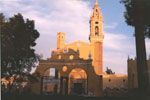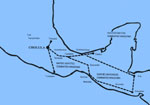
 |
John Pohl's MESOAMERICA |
|||||||
|
MAJOR ARCHAEOLOGICAL SITES: PreClassic to PostClassic CHOLULA (circa A.D. 100-1521) Cholula is not only the oldest continuously occupied ceremonial center in the western hemisphere, but in some respects, one of the most enigmatic. The Acropolis, even larger than Teotihuacán’s Pyramid of the Sun, is a confounding mass of Preclassic to Early PostClassic brick and masonry that defies conventional stratigraphic excavation, while a Late PostClassic city is buried beneath the ever expanding urban growth of the modern community. A succession of excavations have determined relative dates for the major building episodes of the main acropolis. Ethnohistorical studies combined with an urban archaeological survey have confirmed the location of the PostClassic central precinct, including the great temple of Quetzalcoatl. It appears that Cholula evolved from a small village into a regional center during the Late Classic between A.D. 600 and 700. Then between 750 and 950, the town underwent explosive growth as its Olmeca-Xicalanca lords exploited a power vacuum created by their fallen rival, Teotihuacán. The Acropolis thrived along with its Late Classic contemporaries Cacaxtla, Xochicalco, and El Tajín until a new ceremonial center was constructed under the direction of Tolteca-Chichimeca peoples who moved into the region from Tula around A.D. 1100. Cholula then became, in the words of one Spanish chronicler, a New World Mecca, the largest pilgrimage center in highland Mesoamerica and the nucleus of a Nahua commercial exchange network that extended from the Basin of México to El Salvador.
|
||||||||
|
Text links to all pages at this site are available at the FAMSI INDEX |
||||||||


